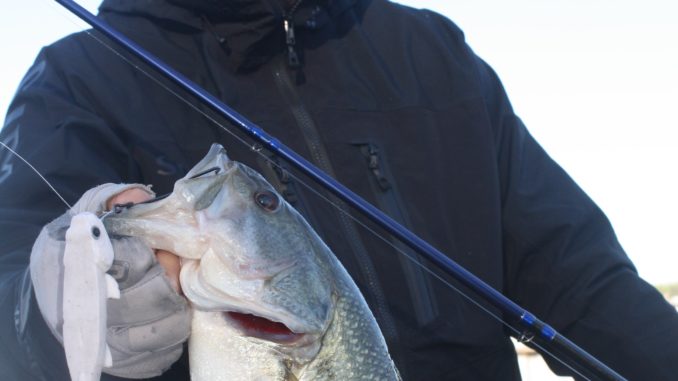
Big swimbaits might catch bruiser bass in California lakes, but downsizing these soft-plastic baits is the way to go in the Carolinas, especially during the prespawn.
With the introduction of Florida-strain largemouth bass into southern California in 1959, fish weighing as much as 20 pounds made that state’s waters treasured fishing grounds for the next world-record fish. Twenty-one of the heaviest 25 bass ever caught have come from California waters, mostly the San Diego city lakes.
To catch huge bass from these heavily pressured, ultra-clear lakes, western fishermen went from one extreme tactic to the other.
First, they employed tiny baits in conjunction with light tackle, giving birth to finesse fishing. Before long, fishermen throughout the country became adept at split-shot fishing, tube jigging and finesse flipping.
Next, with rainbow trout being a major part of the forage bass in California lakes, trophy bass hunters coveted large, imitation trout baits resulting in the swimbait craze.
In contrast to finesse baits, swimbaits measured 8 to 11 inches long and weighed 4 to 6 ounces, and southern California became the swimbait capital of the world. Huge swimbaits, including the Huddleston Swim Shad Deluxe, Castaic Soft Trout, Rago and Savage Gear Real Trout, gained notoriety as big-bass baits.
A major drawback developed once these baits reached other waters. They generated few strikes in lakes with limited numbers of huge bass.
“If you fish those big swimbaits in our waters, you’re not going to get many bites,” said bass pro Matt Arey of Shelby, N.C., who downsizes his swimbaits to increase productivity.
In fact, Arey developed his own swimbait, the Lunkerhunt Fetch, that was introduced at the July 2017 ICAST show. The downsized swimbait met his specifications in action and size, a modest 5-inch model in contrast to the longer, bulkier California versions.
Arey said swimbaits are deadly in the spring and fall. He tested a Fetch prototype last spring at Lake Wylie during the spawning period, using the swimbait in conjunction with a Lunker Stick cigar bait.
Arey likes the swimbait’s versatility in the spring, using it as a search bait for big, prespawn female bass cruising gravel shorelines near spawning grounds or suspended around docks.
“An unweighted Fetch is heavy enough to make long casts along the shoreline while running a few feet below the surface with a steady retrieve,” Arey said. “It can be flipped under docks. Either way, it can be fished quickly to cover a lot of territory. If the fish are suspended in deep water under docks, I’ll use a weighted swimbait hook to make the bait run a foot or two deeper. During the spawning period, I’m fishing water 5 feet deep or less, so deep is a relative term.”
If a bass follows or rolls on the bait but won’t commit to taking it, Arey tosses the Lunker Stick at the same fish. Its slow, spiral fall often triggers a bite.
A third option is what Arey calls a “glide bait,” a broken-back plastic bait that’s retrieved with a tantalizing twitch-and-pause retrieve.
He also checks to see if a bass is locked on its bed. If so, he’ll taunt it with a variety of small baits to get it to strike.
If he’s practicing for a tournament, he marks the bedding fish using waypoints, so he can return to them when money is on the line.
“A swimbait and a cigar-type bait are a great one-two punch for catching prespawn and spawning bass,” he said. “Making long casts with swimbaits while searching for fish is essential, because bass are spooky this time of year.”
To find bedding fish, Arey looks for pockets with hard bottoms and flat banks along the main body, not just at the backs of creeks. He avoids soft, mucky bottoms.
“Bedding bass return to the same places year after year, so once I find these places I know where to begin fishing,” said Arey.
Although he designed the Fetch, Arey ties on as many as five different swimbaits, varying in size, color and action, to trigger strikes.
“A swimbait is a fickle bait,” he said. “I’ll fish a number of them, employing different retrieves until I discover which bait the fish will commit to taking. It’s a clear-water bait, so I use natural colors like shad and bluegill.”
Arey uses Okuma Helios TCS baitcasting reels spooled with 17- to 20-pound fluorocarbon P-Line. The reels are matched to medium-heavy or heavy action 7-foot-3 to 7-foot-6 Okuma rods. He ties swimbaits on with a palomar knot.

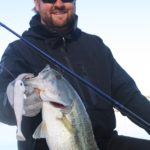
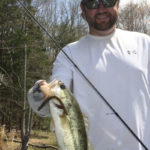
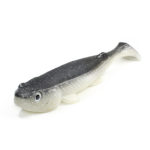
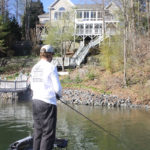
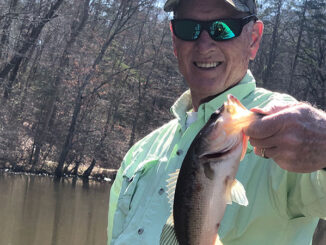
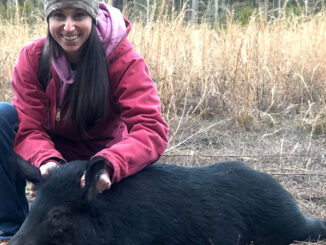
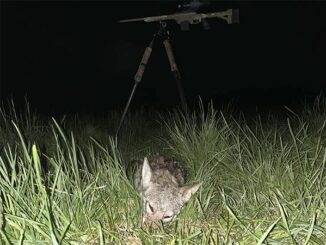
Be the first to comment